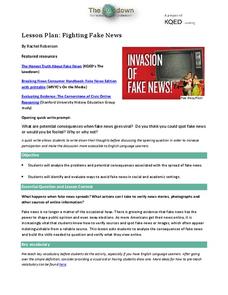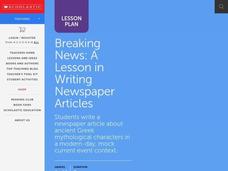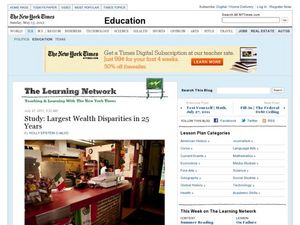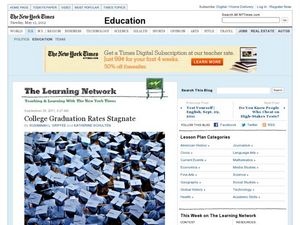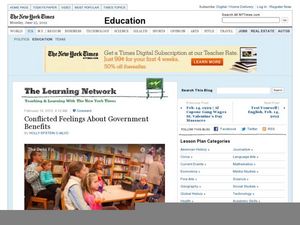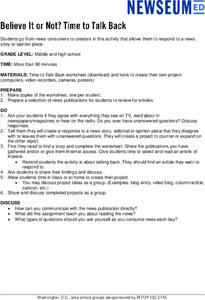Southern Poverty Law Center
Analyzing How Words Communicate Bias
Words are powerful ... can your class choose them wisely? Scholars evaluate news articles to discover the concepts of tone, charge, and bias during a media literacy lesson. The resource focuses on recognizing implicit information and...
Curated OER
Fighting Fake News
Fake news. Alternative facts. Internet trolls. In an age of Newspeak, it's increasingly important to equip 21st century learners with the skills needed to determine the legitimacy of claims put forth on social media, in print, and in...
Curated OER
Breaking News
High schoolers organize a newspaper article using a worksheet that helps them study the vocabulary of news articles. They write newspaper articles about mythical creatures invading contemporary Los Angeles.
Curated OER
Qaddafi Is Dead in Libya
The New York Times posted an article titled, "Qaddafi Is Dead in Libya" back in 2011. Your class gets a chance to read that article to better understand current events and increase their reading comprehension. After reading the article,...
Curated OER
The World's Newest Nation
Reading comprehension can be fostered in many ways. Learners become informed as the read a New York Times article on the South Sudan, the world's newest nation. They read the article and then answer each of the 12 related questions.
Curated OER
The Coachella Festival
A New York Time article on a major music and arts event can be a good way to get kids interested in the daily news. They read an article about Coachella, and then answer eight comprehension questions, in either blog or print form. Note:...
Curated OER
Pass This Jobs Bill
It seems that print media is slowly being replaced by electronic versions. Get your kids reading the New York Times e-style. They'll read the provided article entitled, "Pass This Jobs Bill" then answer six comprehension questions. Two...
Curated OER
Antarctic Exploration
In December of 2011, the New York Times released an article describing new investigations of old Antarctic explorations. Your class will read the article then answer 12 related comprehension questions.
Curated OER
New Rules for Sunscreens
What are UVB and UVB rays, and why isn't my sunscreen good enough? Kids find out all the newest information regarding sunscreen and skin cancer as they read this New York Times article. They read the article then answer eight related...
Curated OER
The Value of Facebook
Does Facebook actually have any value? Find out what the New York Times thinks by reading this informational article. Learners use the 10 guiding questions to aid them as the read the provided article regarding the value of Facebook. Two...
Curated OER
The State of "No Child Left Behind"
Your class can read about the changes Obama considered making to Bush's No Child Left Behind Act. After reading the article, pupils answer 13 questions that ask, who, what, when, where, and why.
Curated OER
Same-Sex Marriage Legalized in New York
Same-sex marriage is the hot topic discussed in this New York Times article. Upper graders read the article and then answer eight comprehension questions. Note: This article is more about the Senate and legislation than about same-sex...
Curated OER
The 'Question of Palestine'
New York Times covers hot topics and current events, now you may use those articles to help young people become more aware. Kids read an article regarding the Israeli-Palestinian agreement and the prospect of Palestine joining the UN....
Curated OER
Racial Tensions for Mixed Families
"Racial Tensions for Mixed Families" is the title of the New York Times article your class gets to read, if they click on this resource. They'll read the article then answer 10 comprehension questions.
Curated OER
Throwing, Passing and Signing
Football players break stereotypes by taking sign language classes to fulfill university language requirements. Learners read this article, then respond to six comprehension questions that ask who, what, when, where, how, and why.
Curated OER
Fill-In: Nicki Minaj
Nicki Minaj is a pop and fashion icon to today's youth. Here, they will read an article about her and what she wore to the MTV Music Awards. They read the article, then attempt to fill in the missing words from several of the paragraphs....
Curated OER
Study: Largest Wealth Disparities in 25 Years
The New York Times has produced an article specifically geared to its younger readers. They read an article entitled, "Largest Wealth Disparities in 25 Years" to answer six comprehension questions. They'll be asked who, what, where,...
Curated OER
College Graduation Rate Stagnate
College has become a way to prepare for the future. However, according to this New York Times article, college graduation rates are stagnating. Kids read the article and then answer nine questions answering who, what, when, where, and...
Curated OER
Fun, and Risks, at the Beach in Tel Aviv
After reading the article "Fun, and Risks, at the Beach in Tel Aviv," learners consider eight related questions. They'll answer who, what, when, where, why, and how about the risks several Palestinian women took as they snuck over the...
Curated OER
Fill-In : Corn Mazes
Can you actually get lost in a corn maze? Kids read how one family was so lost that they called 911 for help. An interesting piece of informational text put out by the New York Times is here to entertain and educate. As they read the...
Curated OER
What Is Your Favorite Place?
Good writing can come from personal places. Budding online authors read an excerpt from a narrative-style newspaper article and then respond to several related writing prompts. They compose blog responses that use vivid imagery to...
Curated OER
Conflicted Feelings About Government Benefits
Government spending on social programs in the US is a big topic. It is also the current event kids will read about as they delve into this issue of the New York Times. They'll read the article, then answer seven comprehension questions....
Newseum
Believe It or Not? Time to Talk Back
Young journalists select a news story, editorial, or opinion piece that they disagree with or one that leaves them with questions. They then create their report in response and share it with the class.
Breaking News English
Facebook Depression
Students read the article, answer true and false questions, complete synonym matching, complete phrase matching, complete a gap fill, answer short answer questions, answer discussion questions, write, and more about Facebook Depression....

